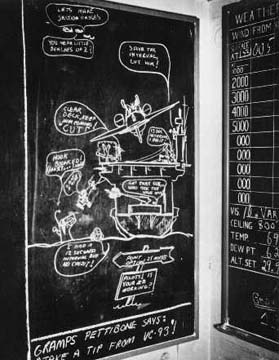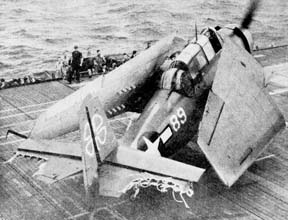|
This extra distance that Wells had traveled, to disobey
instructions, ran his fuel so low that by the time he got back
to the ships he was practically on fumes. Since our carrier was
not taking planes aboard at the time and one of the other formation
of carriers was receiving planes, Wells got into their traffic
circle and landed on one of those carriers. The landing was a
little short and the tail wheel struck the curved portion of
the after-end of the flight deck. This sprung the back of the
plane rendering it temporarily unflyable. The Captain of that
ship called Wells to the bridge wanting to know what the hell
he was doing on his ship. Wells told him that he was nearly out
of fuel and would not have been able to wait for the Petrof Bay's
formation to start landing planes. The captain called to have
the gas tank on Well's plane checked and the report was that
there was only a cupful left.
Wells was off the hook on that score but he still had to get
back to our ship and he didn't have a plane since his was damaged
with a broken back, full of holes and grounded. You can believe
it or not but he talked that captain into trading his plane for
one of theirs and on the next flight flew the new one back to
the Petrof Bay. For all his shenanigans, Wells was given three
days in hack (restricted to his room). He was not to be lonely,
he had eight roommates.
|
At some point in our daily operations, I began getting
an uneasy feeling in the traffic circle when approaching for
a landing, especially in the final turn into the stern of the
carrier. This didn't happen once, but was getting to be a regular
occurrence. The feeling I would get was that the plane was gradually
rolling to the left and was about to roll right into the ocean.
Not just one plane but any plane I happened to be flying. There
seemed to be nothing I could do to stop the roll in that I had
the stick as far to the right as it would go. By the grace of
God I managed to get aboard each time. Not only was I concerned,
but the landing signal officer was after me because I was not
responding to his signals quickly enough. He was not able to
offer me any constructive advice and I knew that I had to solve
the situation or I was going to wind up in the water. |

VC 93 humor |
One day as I was experiencing this feeling, I decided to turn
the plane loose and see what would happen. This moment came almost
immediately. On the turn to the down wind leg at about 50 feet
of altitude, I again had the stick full right and was at the
limit of my control. I pulled my feet off the rudder pedals and
took my hand off the stick. I was no longer flying the plane,
it was on it own. To my surprise the left wing came up and the
plane leveled out and was flying very nicely, straight and level.
I may be thick headed but it didn't take me but an instant to
recognize what I had been doing. Being intent on following the
procedures for the approach and landing I was, without being
aware it, applying pressure to left rudder pedal causing the
plane to roll and applying right aileron to hold the left wing
up. This was cross controlling the plane. If I had been flying
a straight line in place of turning I would have been slipping
the plane just as I had done in slips to a circle. I was never
to make that mistake again. Landings were normal again.

Lt. Tuttle's damaged TBM |
The squadron suffered at least 110 incidents of damage
to it's planes due to enemy antiaircraft fire. I am aware of
only one time that my plane was hit by enemy gun fire. I became
aware of that only after I landed and the plane captain pointed
out a machine gun air scoop that had been split open. Was very
minor and didn't interfere with the flight characteristics of
the plane.
On one of our strafing missions on the islands of Miyako and
Ishigaki Shima we were to bomb and strafe |
the airfields to damage the runways so that enemy aircraft could
not fly in from Formosa, land, refuel and take off for Kamikaze
runs on Okinawa. These were two very small islands about half
way between Formosa and Okinawa. We would start our runs from
about 10,000 feet and pull out just above the tree tops. In the
dive of one of my runs, my plane began shaking and thrashing
around so violently that I could no longer hold the stick, even
with both hands. I assumed that I had taken a hit from AA fire
and the plane was out of control and that I had no choice but
to jump. I took my hands off the stick, reached for the canopy
release. In a matter of seconds I needed to be out of the plane
before it hit the ground. When I released the controls, the plane
came out of it's dive and began to lose airspeed. As it lost
speed it became less the violent and I realized that I might
again be able to get control. This did happen and at a lower
speed I had normal control again. I circled the island until
my flight had completed its runs, then rejoined them. To fly
with them I had to increase my airspeed to match theirs but this
caused the severe vibrations to return. The skipper assigned
one of the TBMs to escort me back to the ship while they went
ahead of us. The rest of my flight and landing were normal. As
soon as the plane was on the deck we scrutinized the plane for
the cause of the trouble. What we found was that one of the connecting
rods that tied the control wire from the stick to the trim tab
on the elevator had stripped its treads and the tab was free
to flop on it's hinges. At low speeds there was little or no
effect but at high speed as in a near vertical dive a small movement
up and down would cause a great amount of movement in the forward
end of the plane. It was this great amount of movement caused
by a little flutter that I was experiencing.
A couple of years after the war had ended I read in
the Des Moines newspaper that the Army had discovered the graves
of nine Navy and Marine fliers who had been shot down and taken
prisoner on these two islands. They were flown to Formosa and
executed. I have no reason to doubt the story. Not only did I
have trouble over these two islands but we lost three or four
planes there. One crashed in the ocean and the pilot was killed.
The other pilots were rescued by seaplanes or by a submarine.
In fact, the skipper was shot down over these islands twice.
The first time we circled over him while he was in the water
waiting for the "Dumbo" to show up. I was sure that
the wrong coordinates were given for this location so when the
"Dumbo" didn't show I kept looking in the direction
that I expected it to be. Sure enough I spotted a very tiny dot
in the sky to the west. I was not able to raise the leader of
our flight on the radio, so without notifying Dunagan, I took
off and flew to the dot, discovered the dot to be the rescue
plane and led it back. I've often wondered if we might have lost
the skipper if I hadn't noticed the error in the coordinates.
The second time the skipper was shot down over these islands
he was picked up by a submarine and spent three weeks aboard
before being returned to Okinawa and back to the carrier. |